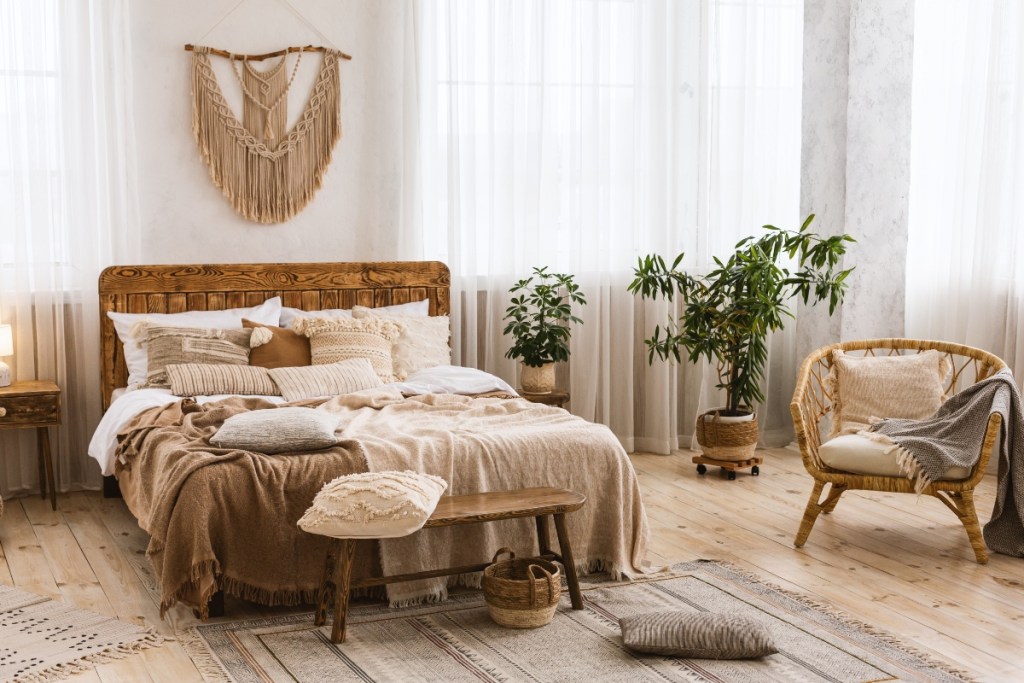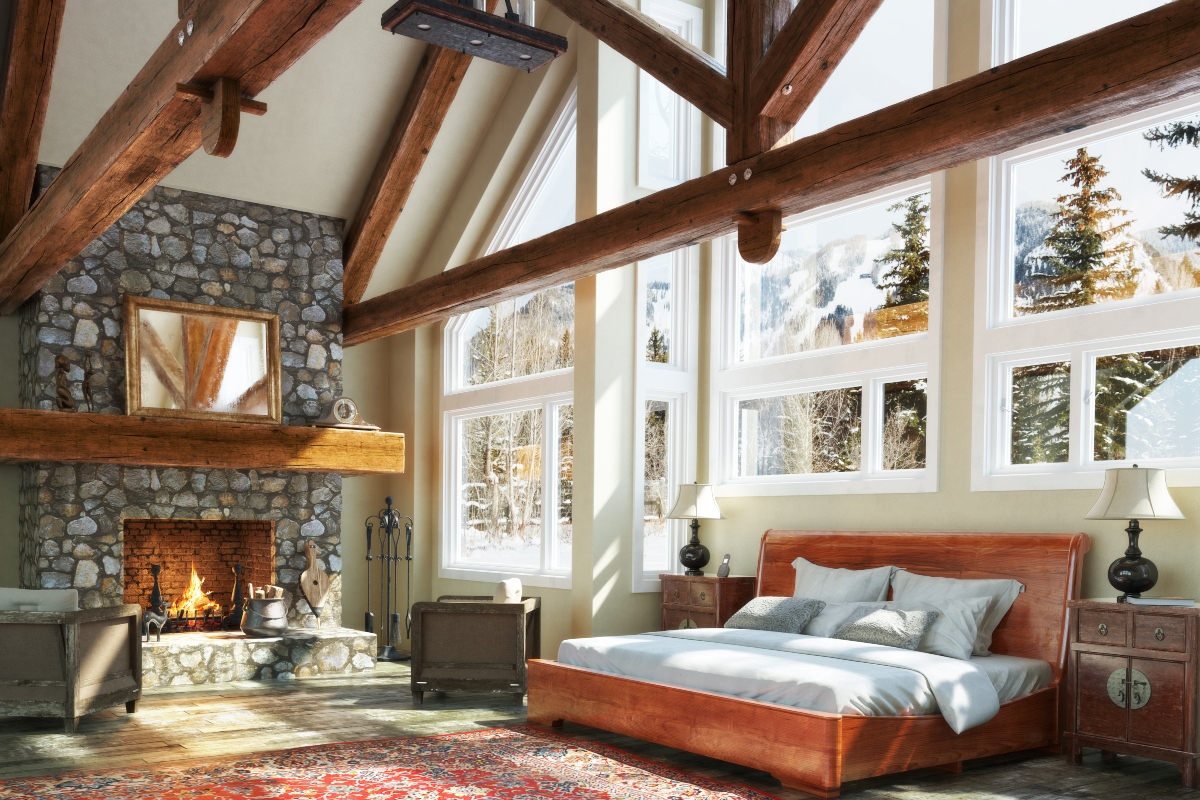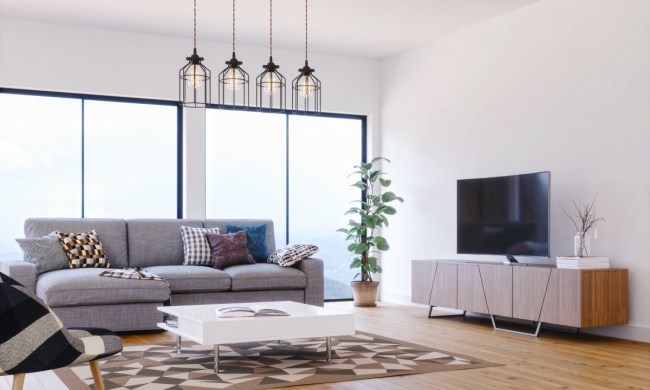Rustic Scandinavian interior design is a great way to blend the stark simplicity of Scandinavian decor with inviting, rich and organic materials in your home. With their shared emphasis on nature, these two interior design styles have become the perfect duo for homeowners looking for a rugged yet refined look for their spaces. Below is everything you need to know about rustic Scandinavian design and how you can achieve this stunning look in your home.
What is rustic Scandinavian interior design?

Rustic Scandinavian interior design is achieved by marrying both rustic and Scandi decor. This pairing can seem unusual at first glance. Where rustic decor is well known for its dark and woody interiors, Scandinavian design is often dominated by stark color palettes and minimalism. However, these two design styles have a few details in common that allow them to blend together beautifully in any room. For example, both styles incorporate raw materials and unfinished wood pieces into their aesthetics.
Below is a deeper look into both Scandinavian design and rustic interiors to help you gain a better idea of how these two seemingly opposite design styles have come together to create a unique and cozy aesthetic.
What is Nordic hygge style?
Nordic hygge style is part of the Scandinavian design family tree and focuses on the Danish idea of “hygge,” which is the feeling of being content with the simple pleasures in life. The Scandinavian design style, in general, uses Nordic-inspired designs and mountain home decor. Therefore, when aiming to blend Scandi and rustic interior decor, many designers lean into the Nordic hygge style to achieve a comfortable balance.
You might be asking yourself, “What characterizes Scandinavian interior design?” Scandinavian decor is often created with minimal decoration, stark color palettes, and unfinished, light-colored wood furniture. However, Nordic and hygge styles expand this idea by inviting more soft lighting, clutter, textiles, dark wood tones, and comforting decor into the interior design. Through this subsect of Scandinavian interior design, designers can better pair the style with rustic decor to create the perfect blend.
What is rustic interior design?
Alternatively, rustic interior design heavily relies on dark tones, wood materials, masonry, dark color palettes, and plenty of natural or organic elements. Unlike traditional Scandinavian decor, rustic design focuses on plenty of layering and furniture that provides a warm and cozy feeling. However, rustic interior design also shares similarities to Scandi decor through unfinished or raw wood tones, an emphasis on natural materials, and a cozy cabin or mountain aesthetic.
How to achieve rustic Scandinavian interior design

Achieving the rustic Scandinavian interior design style is simple. While it’s important to blend the two opposing aesthetics together, they share enough elements in common that you can still create a cohesive look.
Stark and contrasting color palettes
An easy way to blend these two design styles is to use stark and contrasting colors. Use white as a base in your color palette, preferably a shade that feels cold or has a blue undertone. Then pair this shade with darker hues like rich brown, black, or steel gray. Pair both warm and cool shades to create the perfect look in your design. The key factor is to achieve a balance between the warm, dark hues and the cool, light ones to create the best effect. The contrast will help you create the perfect juxtaposition between rustic and Scandi decor.
Organic and natural decor
While the color palettes for these two design styles are on opposing ends of the color spectrum, the styles both favor organic and natural decor. Because of this, we recommend you focus on using plenty of natural decor in your design to create a cohesive union. Organic pieces like fur (or faux fur) rugs or blankets, masonry, wood tables and chairs, wool blankets, plants, and other natural decor pieces are great choices for creating a rustic Scandinavian look. Using various natural materials is a great way to create more dimension and balance within your design.
Unfinished wood pieces
Another similarity between Scandinavian and rustic aesthetics is that both styles make heavy use of unfinished wood pieces. However, Scandinavian designs often use light-toned woods, while rustic styles prefer dark-toned materials. So if you’re aiming for a blend of these two design styles, there are two ways you might go about achieving a cohesive look.
First, you could consider using mid-toned wood pieces. Choose wooden tables, chairs, or other accent pieces that are unfinished and made of a mid-tone wood like oak or elm. Your second option is to enhance the contrast between these two design styles by pairing your light-toned wood pieces with a darker color palette and pairing darker-toned wood furniture with a lighter color palette. Using wood tones like birch and aspen with a dark backdrop, or walnut and hickory tones with a white backdrop, will help you create more visual contrast within your design.
Layered fabrics
Another way you can create a beautiful union between Scandinavian and rustic decor is to layer your fabrics. For example, opt for layered rugs, multiple blankets on furniture, and fur or faux fur textiles draped over wooden chairs or benches. By layering your fabrics, you can add more texture to the overall design and lean into rustic design’s need for organic textiles. Additionally, layering your fabrics helps to enhance the hygge quality of your design, which will help bring out more Scandinavian influences.
What to avoid when decorating a rustic Scandinavian interior

The key to pulling off a successful rustic Scandinavian interior is about striking the perfect balance between the two styles. However, this can be challenging, so here are some tips on what to avoid when working with this design style.
Too many raw or unpolished elements
Rustic interiors thrive on unfinished or raw materials. Think wood pieces with rough bark on the edges or roughly cut stonework. However, Scandi interiors are all about clean lines and a minimalist aesthetic. When using natural materials, aim for well-polished or clean-cut pieces. For example, polished stone accents can appeal to both rustic and Scandi styles.
Too much clutter
Since Scandinavian design is all about intentional pieces, avoid decorating with too much clutter. While you may want to show off some rustic knick-knacks on shelves, keep additions to a minimum.
Not a good blend of light and dark tones
Overall, you’ll want to find a good balance between light and dark tones. Dark walnut wood can pull in a rustic touch, while crisp, light stone might adhere more to a Scandi palette.
What is the difference between Scandi and Japandi interior design?

While both Japandi and Scandi styles borrow motifs and inspiration from minimalism, they represent this aesthetic with influences from their surrounding cultures in unique ways.
Japandi tends to lean into warmer tones, such as lush browns and deep creams with undertones of red and yellow. Additionally, Japandi is known for blending light and dark woods, focusing on higher contrast within the design, and adding more dramatic flair to its minimal design style. Japandi also borrows many culturally relevant influences for its design style, like adding bamboo pieces or using slatted wall decor.
Scandi, however, favors lighter wood tones and a more crisp appeal to the design. Cool hues with undertones like green and blue reign supreme. You may also find fur or faux fur textiles, muted gray tones, and simple, near-monochromatic color palettes in Scandi spaces. Additionally, Scandi designs play around with more layering and natural materials like wool or leather for a cozier look. Scandi interior design may also appear more rustic and industrial than its Japandi counterpart.
No matter how you blend these two design styles, it’s important to aim for a balanced look. Try not to lean too heavily into either Scandinavian or rustic design. Instead, focus on creating contrast with your color palette and textures, and don’t forget to aim for a cozy hygge aesthetic that will help you seamlessly blend these two opposing styles.




